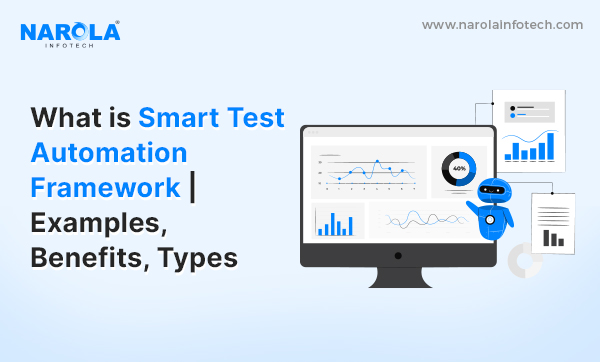Embrace the Evolution in Software Testing
In recent years, there's been a game-changing shift in software testing from manual to automated processes. While manual testing had its merits, it often grappled with limitations in test coverage, quality, and speed, slowing down the software delivery momentum.
Enter automated testing—a powerhouse solution, that addresses these limitations by ensuring comprehensive test coverage, delivering higher software quality, and significantly accelerating release cycles. Yet, traditional automated testing had its own set of challenges.
Complex scripting, tricky integrations, and time-consuming setups demanded significant investments and patience before reaping the benefits.
Introducing the Smart Test Automation Framework
Say farewell to the drawbacks of traditional automation. The Smart Test Automation Framework takes center stage, leveraging cutting-edge technologies like artificial intelligence and machine learning. It offers a transformative approach, simplifying and streamlining automated testing, eliminating pain points associated with conventional methods.
If you're on the lookout for a seamless software testing process, this blog is your go-to resource. Discover what a Smart Test Automation Framework entails, explore its benefits, and dive into the various types of frameworks.
What is the Smart Test Automation Framework?
The Smart Test Automation Framework is a game-changer in software testing automation. Going beyond traditional frameworks, it leverages AI and other technologies to enhance testing efficiency and effectiveness. Key features include:
1. Self-healing tests
Automatically detects and recovers from unexpected changes, minimizing manual intervention.
2. AI-powered test case generation
Analyzes existing test cases and generates new ones for better test coverage.
3. Predictive analytics
Identifies potential defects early, preventing issues from reaching production.
4. Self-documenting tests
Automatically generates clear and concise documentation for effective collaboration.
5. Integration with CI/CD pipelines
Seamlessly integrates with Continuous Integration and Continuous Delivery Pipelines for automated testing throughout development.
Examples of Smart Test Automation Frameworks
1. Tavant's Smart Test Automation Platform (STAP)
Harnesses AI, self-deployable frameworks, and advanced automation for unparalleled efficiency.
2. Testsigma
A revolutionary AI-powered test automation platform, empowering testers of all levels.
3. Smart Test Automation by Reply
Utilizes AI, specifically a neural network model, for "smart" testing of in-use services.
5 Ways Smart Test Automation Framework Transforms Your Testing Process
1. Increased Efficiency
- Faster Test Creation: AI-powered features reduce manual scripting effort.
- Parallel Test Execution: Simultaneous testing across platforms accelerates feedback loops.
- Automated Test Maintenance: Self-healing capabilities adapt to changes, ensuring stability.
2. Improved Test Coverage
- AI-Driven Test Case Generation: Analyzes and generates new test cases for comprehensive coverage.
- Pre-built Frameworks: Offers frameworks for web, mobile, and APIs for diverse testing scenarios.
- Data-Driven Testing: Easily creates test scenarios with diverse datasets.
3. Reduced Maintenance Costs
- Self-Documenting Tests: Automation of documentation saves time and effort.
- Self-Healing Tests: Adapts to changes, minimizing manual intervention.
- Visual Validation: Identifies visual regressions through screenshot comparisons.
4. Enhanced Software Quality
- AI-Powered Defect Detection: Identifies defects with high accuracy for proactive resolution.
- Predictive Analytics: Anticipates risks early, preventing issues in production.
- CI/CD Integration: Ensures automated testing throughout the development lifecycle.
5. Improved Collaboration
- Intuitive Interface: User-friendly design fosters collaboration among teams.
- Centralized Test Management: All test artifacts are stored centrally for easy access.
- Comprehensive Reporting: Detailed reports provide insights for informed decision-making.
5 Popular Smart Test Automation Frameworks to Choose From
Explore different types of frameworks for various testing needs:
1. Linear Scripting Framework
Ideal for simple applications with predictable behavior, easy to use but may lack flexibility.
2. Modular Testing Framework
Enhances maintainability and scalability, suitable for complex applications with diverse functionality.
3. Data-Driven Framework
Ensures comprehensive test coverage by executing tests with various data combinations.
4. Keyword-Driven Framework
Requires no programming, making it accessible for testers with limited coding experience.
5. Hybrid Framework
Combines the strengths of multiple frameworks, offering flexibility and adaptability.
Reduce Your Testing Time by 80% with Narola Infotech
The Smart Test Automation Framework revolutionizes testing, optimizing resources, accelerating software delivery, and ensuring high-quality results. Narola Infotech is your partner in embracing this innovation.
Don't let traditional complexities hinder your progress. Take the first step towards smarter, efficient testing. Contact us today and discover how our Smart Test Automation Services can propel your software development goals to new heights!
Source: What is Smart Test Automation Framework | Examples, Benefits, Types
Read more: Top 7 Manual Testing Tools You Should Know
5 Best API Testing Tools That Will Revolutionize Your Development Process

Comments
Post a Comment